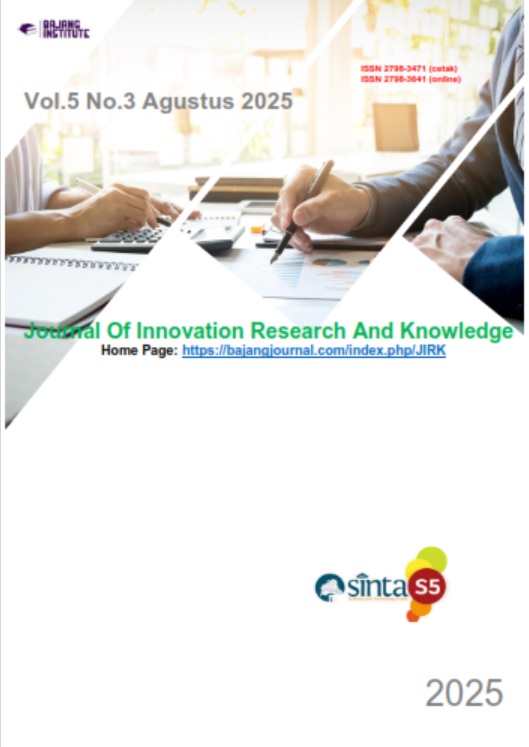THE EFFECT OF LEARNING MOTIVATION THROUGH STUDENTS’ READING ABILITY ON ENGLISH LEARNING ACHIEVEMENTS
Keywords:
Learning Motivation, Students’ Reading Ability, English Learning AchievementsAbstract
This study aimed to examine the effect of learning motivation and students' reading ability on English learning achievements. The research employed a survey method with correlational and regression analysis to investigate the relationship among the variables. The participants were second semester students of the English Education Study Program at Universitas Subang. Data collected through classroom observations, interviews, and students' tests. The findings revealed that learning motivation and reading ability simultaneously had a significant effect on students' English learning achievements (F = 55.024, Sig. = 0.000). The regression model showed a strong relationship (R = 0.812) and explained 65.9% of the variance in English achievement (R² = 0.659). Partially, learning motivation (β = 0.378, t = 5.161, Sig. = 0.000) contributed more strongly (Beta = 0.520) compared to reading ability (β = 0.307, t = 3.697, Sig. = 0.000; Beta = 0.373). These results indicate that students with higher learning motivation and better reading ability tended to achieve better outcomes in English learning. The study concludes that learning motivation plays a more dominant role than reading ability in improving English learning achievements. It suggests that teachers should foster students' motivation alongside reading strategies to enhance their academic success in English.
References
Gardner, R. C., & Lambert, W. E. (1972). Attitudes and motivation in second-language learning. Newbury House.
Dörnyei, Z. (2005). The psychology of the language learner: Individual differences in second language acquisition. Lawrence Erlbaum Associates.
Piaget, J. (1970). Psychology and pedagogy. Viking Press.
Schunk, D. H., Pintrich, P. R., & Meece, J. L. (2014). Motivation in education: Theory, research, and practice (4th ed.). Pearson Higher Ed.
Vygotsky, L. S. (1978). Mind in society: The development of higher psychological processes. Harvard University Press.
Bandura, A. (1997). Self-efficacy: The exercise of control. W.H. Freeman.
Mills, N., Pajares, F., & Herron, C. (2007). Self-efficacy of college intermediate French students: Relation to achievement and motivation. Language Learning, 57(3), 417–442. https://doi.org/10.1111/j.1467-9922.2007.00421.x
Zimmerman, B. J. (2000). Self-efficacy: An essential motive to learn. Contemporary Educational Psychology, 25(1), 82–91. https://doi.org/10.1006/ceps.1999.1016
Maslow, A. H. (1943). A theory of human motivation. Psychological Review, 50(4), 370–396. https://doi.org/10.1037/h0054346
Deci, E. L., & Ryan, R. M. (2000). The “what” and “why” of goal pursuits: Human needs and the self-determination of behavior. Psychological Inquiry, 11(4), 227–268. https://doi.org/10.1207/S15327965PLI1104_01
Skinner, B. F. (1957). Verbal behavior. Appleton-Century-Crofts.
Brophy, J. (2010). Motivating students to learn (3rd ed.). Routledge.
Wigfield, A., & Guthrie, J. T. (1997). Relations of children’s motivation for reading to the amount and breadth of their reading. Journal of Educational Psychology, 89(3), 420–432. https://doi.org/10.1037/0022-0663.89.3.420
Bruner, J. S. (1966). Toward a theory of instruction. Harvard University Press.
Pressley, M. (2006). Reading instruction that works: The case for balanced teaching (3rd ed.). Guilford Press.
Guthrie, J. T., & Wigfield, A. (2000). Engagement and motivation in reading. In M. L. Kamil, P. Mosenthal, P. D. Pearson, & R. Barr (Eds.), Handbook of reading research (Vol. 3, pp. 403–422). Lawrence Erlbaum Associates.
Baker, L., & Wigfield, A. (1999). Dimensions of children’s motivation for reading and their relations to reading activity and reading achievement. Reading Research Quarterly, 34(4), 452–477. https://doi.org/10.1598/RRQ.34.4.4
Schunk, D. H., & Pajares, F. (2009). Self-efficacy theory. In K. R. Wentzel & A. Wigfield (Eds.), Handbook of motivation at school (pp. 35–53). Routledge.
Huitt, W. (2001). Motivation to learn: An overview. Educational Psychology Interactive. Valdosta State University. http://www.edpsycinteractive.org
Gardner, R. C., & Lambert, W. E. (1972). Attitudes and motivation in second-language learning. Newbury House.
Anderson, N. J. (2003). Scrolling, clicking, and reading English: Online reading strategies in a second/foreign language. The Reading Matrix, 3(3), 1–33.
Grabe, W., & Stoller, F. L. (2011). Teaching and researching reading (2nd ed.). Routledge.
Hutchinson, T., & Waters, A. (1987). English for specific purposes: A learning-centred approach. Cambridge University Press.
Hutchinson, T., & Waters, A. (1991). English for specific purposes. Cambridge University Press.
Hans, A., & Hans, E. (2015). A comprehensive study of the concept of motivation. International Journal of Management and Social Sciences Research, 4(1), 1–10.
Falaus, A. (2017). Challenges in teaching ESP: Adapting materials to students’ needs. Journal of Innovation in Psychology, Education and Didactics, 21(1), 53–62.
Basturkmen, H., & Bocanegra-Valle, A. (2018). Materials design processes, beliefs and practices of experienced ESP teachers in university settings in Spain. Ibérica: Revista de la Asociación Europea de Lenguas para Fines Específicos (AELFE), 36, 57–80.
Maulida, I. (2023). An analysis of development ICT in learning environment on ESP classroom. Jurnal Bina Ilmiah, 17(10), 1141–1416. https://binapatria.id/index.php/MBI/article/view/423/335
Maulida, I., Aminah, M., & Hermawan, N. S. (2023). The effect of students’ motivation in the ESP classroom through learning English achievement on students’ computer science. Jurnal Bina Ilmiah, 17(7), 1141–1416. https://binapatria.id/index.php/MBI/article/view/269/220
Daar, G. F. (2019). Problems of English language















